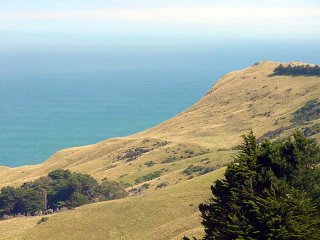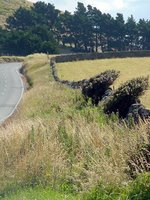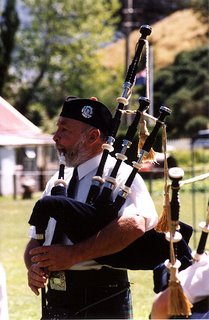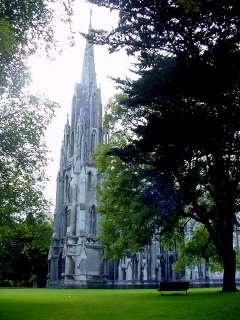
Dunedin ... it's home for me and when I get homesick, I travel its roads and revisit the places of memory.
My favourite place in the city was Otago Peninsula, I would drive out on the low road, alongside the harbour and come back over the high road, past the stone walls built by Scottish settlers in the late 19th century ... the approach to the city is stunning from up there.
The peninsula road, otherwise known as Portobello Road, winds its way around the edge of Dunedin's Otago harbour. You pass through picturesque little villages like MacAndrew Bay, Broad Bay and Portobello, driving on until you reach Taiaroa Head ... with cliffs that plunge straight down and into the Pacific Ocean.
Taiaroa Head is home to the only mainland-based albatross colony in the world. This giant bird, with a wing span of up to 3 metres, flies an estimated 190,000 km per year and lays its single egg at the colony. Hatched, the young birds grow and leave the peninsula, following an instinct to skim oceans, only coming back to breed after 3 to 6 years.

Although you pay to visit the albatross, on the beach below you can wander freely, sometimes amongst seals, sometimes watching the penguins come home in the evening. Our beaches are stunning places. I've shared them with sea lions, seals and an injured Leopard seal; I've watched various penguin breeds come home in the late afternoon, and baby seals riding the waves just a few metres in front of me. And although I didn't know it until years later, Dunedin has more than its fair share of sharks ... my old and beloved swimming beach, Brighton, is rumoured to be a shark breeding ground. St Kilda, a city beach, has been the scene of two deaths by shark. Nevertheless Dunedin has a big surfing population of hardy souls who regularly brave the cold waters.
The harbour-side of the peninsula is rolling hills, space and light; the east coast Pacific ocean side has always seemed brooding to me ... I'm not sure why. It's wilder, with steep hills that dramatically drop away into the ocean however I did love sitting just below the top of the hill in the second photograph ... you look out over the ocean, knowing there's nothing for thousands of kilometres ... it was a favourite place.

My passion for Dunedin was definitely centered around the harbour ... a clear frosty night gave the morning reward of a harbour so still that it looked like glass ... I used to disappear with my camera searching for photographs; expeditions that resulted in a collection of rowboats on still water. I could never resist
just one more boat.
But there is so much more to Dunedin ... the first European settlers arrived hundreds of years after the original Maori settlers and took over. An act that wasn't redressed until the end of the 20th century ... when attempts to honor the Treaty of Waitangi were finally made. However, back in 1848, 97 passengers on the John Wickliffe arrived in the Port of Otago ... 4 months after leaving the British Isles and sailing across the Atlantic, then round the Cape of Good Hope on Africa's southern tip before being blown across the roaring 40's in the southern ocean. They traveled south under Australia then on round the southern coast of New Zealand before heading north and docking at the Port of Otago.

The name Dunedin is the old Gaelic name for Edinburgh and that Scottish flavour is still present today ... found in our pipe bands, haggis ceremonies and perhaps in our general sensibility. The Scots made two major contributions to Dunedin ... education and religion; setting a stiff religious tone that invited a creative rebellion in the poets, musicians and writers of later generations ... James K Baxter and Janet Frame to name two.
Otago University was founded in 1869 and is the oldest in New Zealand. Otago Boys High School was founded in 1864, and Otago Girls High followed in 1871 - it was the first state run secondary school for girls in the world.

But the Scots weren't the only influence, a goldrush began in 1861 and meant that Dunedin's Port of Otago created a wee economic miracle for some years, as an entry point for men and goods and an exit point for gold. As a result of this economic boom, we have a rather wonderfully diverse, if unusual, collection of architecture...
there are few places in the world where such a variety of architectural styles can be seen virtually rubbing shoulders with each other. From the Flemish Renaissance railway station, one's eye can travel directly opposite to the Gothic detail on the Law Courts, along to the Queen Anne touches on the Police Station and up towards the Italianate clock tower-topped Municipal Chambers.
The Greek revival bank, a cluster of mid-Victorian commercial buildings ... and up on the hill slopes above the city, Tudor, Jacobean and Georgian style dwellings stand side by side with Carpenter Gothic and Arts and Crafts styles.
Victorian industrial buildings like the elegant brick Crown Flour Mill, the former Shacklock coal range foundry nearby and the Edwardian - modestly Queen Anne - former City Gasworks each make its own impressive stand, as do quaint rows of terrace houses, some looking straight from industrial England.
You get the idea ...

But perhaps all this activity also created an unusual people ... we like to think so ... unusual in a good way. The Scottish settlers gave us an ability to work hard , a strong founding economy with a weighting on education, and traveling so far to a new life surely developed a fierce independence.
They were followed by the gold miners, who added to the mix, bringing their spirit of enterprise, their love of sport, a strong tradition of music and theatre and a financial boom which meant that we ended up with our rather magnificent architecture.
Dunedin, it's a city of natural and architectural beauty ... it's my home town.
 Dunedin ... it's home for me and when I get homesick, I travel its roads and revisit the places of memory.
My favourite place in the city was Otago Peninsula, I would drive out on the low road, alongside the harbour and come back over the high road, past the stone walls built by Scottish settlers in the late 19th century ... the approach to the city is stunning from up there.
The peninsula road, otherwise known as Portobello Road, winds its way around the edge of Dunedin's Otago harbour. You pass through picturesque little villages like MacAndrew Bay, Broad Bay and Portobello, driving on until you reach Taiaroa Head ... with cliffs that plunge straight down and into the Pacific Ocean.
Taiaroa Head is home to the only mainland-based albatross colony in the world. This giant bird, with a wing span of up to 3 metres, flies an estimated 190,000 km per year and lays its single egg at the colony. Hatched, the young birds grow and leave the peninsula, following an instinct to skim oceans, only coming back to breed after 3 to 6 years.
Dunedin ... it's home for me and when I get homesick, I travel its roads and revisit the places of memory.
My favourite place in the city was Otago Peninsula, I would drive out on the low road, alongside the harbour and come back over the high road, past the stone walls built by Scottish settlers in the late 19th century ... the approach to the city is stunning from up there.
The peninsula road, otherwise known as Portobello Road, winds its way around the edge of Dunedin's Otago harbour. You pass through picturesque little villages like MacAndrew Bay, Broad Bay and Portobello, driving on until you reach Taiaroa Head ... with cliffs that plunge straight down and into the Pacific Ocean.
Taiaroa Head is home to the only mainland-based albatross colony in the world. This giant bird, with a wing span of up to 3 metres, flies an estimated 190,000 km per year and lays its single egg at the colony. Hatched, the young birds grow and leave the peninsula, following an instinct to skim oceans, only coming back to breed after 3 to 6 years.
 Although you pay to visit the albatross, on the beach below you can wander freely, sometimes amongst seals, sometimes watching the penguins come home in the evening. Our beaches are stunning places. I've shared them with sea lions, seals and an injured Leopard seal; I've watched various penguin breeds come home in the late afternoon, and baby seals riding the waves just a few metres in front of me. And although I didn't know it until years later, Dunedin has more than its fair share of sharks ... my old and beloved swimming beach, Brighton, is rumoured to be a shark breeding ground. St Kilda, a city beach, has been the scene of two deaths by shark. Nevertheless Dunedin has a big surfing population of hardy souls who regularly brave the cold waters.
The harbour-side of the peninsula is rolling hills, space and light; the east coast Pacific ocean side has always seemed brooding to me ... I'm not sure why. It's wilder, with steep hills that dramatically drop away into the ocean however I did love sitting just below the top of the hill in the second photograph ... you look out over the ocean, knowing there's nothing for thousands of kilometres ... it was a favourite place.
Although you pay to visit the albatross, on the beach below you can wander freely, sometimes amongst seals, sometimes watching the penguins come home in the evening. Our beaches are stunning places. I've shared them with sea lions, seals and an injured Leopard seal; I've watched various penguin breeds come home in the late afternoon, and baby seals riding the waves just a few metres in front of me. And although I didn't know it until years later, Dunedin has more than its fair share of sharks ... my old and beloved swimming beach, Brighton, is rumoured to be a shark breeding ground. St Kilda, a city beach, has been the scene of two deaths by shark. Nevertheless Dunedin has a big surfing population of hardy souls who regularly brave the cold waters.
The harbour-side of the peninsula is rolling hills, space and light; the east coast Pacific ocean side has always seemed brooding to me ... I'm not sure why. It's wilder, with steep hills that dramatically drop away into the ocean however I did love sitting just below the top of the hill in the second photograph ... you look out over the ocean, knowing there's nothing for thousands of kilometres ... it was a favourite place.
 My passion for Dunedin was definitely centered around the harbour ... a clear frosty night gave the morning reward of a harbour so still that it looked like glass ... I used to disappear with my camera searching for photographs; expeditions that resulted in a collection of rowboats on still water. I could never resist just one more boat.
But there is so much more to Dunedin ... the first European settlers arrived hundreds of years after the original Maori settlers and took over. An act that wasn't redressed until the end of the 20th century ... when attempts to honor the Treaty of Waitangi were finally made. However, back in 1848, 97 passengers on the John Wickliffe arrived in the Port of Otago ... 4 months after leaving the British Isles and sailing across the Atlantic, then round the Cape of Good Hope on Africa's southern tip before being blown across the roaring 40's in the southern ocean. They traveled south under Australia then on round the southern coast of New Zealand before heading north and docking at the Port of Otago.
My passion for Dunedin was definitely centered around the harbour ... a clear frosty night gave the morning reward of a harbour so still that it looked like glass ... I used to disappear with my camera searching for photographs; expeditions that resulted in a collection of rowboats on still water. I could never resist just one more boat.
But there is so much more to Dunedin ... the first European settlers arrived hundreds of years after the original Maori settlers and took over. An act that wasn't redressed until the end of the 20th century ... when attempts to honor the Treaty of Waitangi were finally made. However, back in 1848, 97 passengers on the John Wickliffe arrived in the Port of Otago ... 4 months after leaving the British Isles and sailing across the Atlantic, then round the Cape of Good Hope on Africa's southern tip before being blown across the roaring 40's in the southern ocean. They traveled south under Australia then on round the southern coast of New Zealand before heading north and docking at the Port of Otago.
 The name Dunedin is the old Gaelic name for Edinburgh and that Scottish flavour is still present today ... found in our pipe bands, haggis ceremonies and perhaps in our general sensibility. The Scots made two major contributions to Dunedin ... education and religion; setting a stiff religious tone that invited a creative rebellion in the poets, musicians and writers of later generations ... James K Baxter and Janet Frame to name two.
Otago University was founded in 1869 and is the oldest in New Zealand. Otago Boys High School was founded in 1864, and Otago Girls High followed in 1871 - it was the first state run secondary school for girls in the world.
The name Dunedin is the old Gaelic name for Edinburgh and that Scottish flavour is still present today ... found in our pipe bands, haggis ceremonies and perhaps in our general sensibility. The Scots made two major contributions to Dunedin ... education and religion; setting a stiff religious tone that invited a creative rebellion in the poets, musicians and writers of later generations ... James K Baxter and Janet Frame to name two.
Otago University was founded in 1869 and is the oldest in New Zealand. Otago Boys High School was founded in 1864, and Otago Girls High followed in 1871 - it was the first state run secondary school for girls in the world.
 But the Scots weren't the only influence, a goldrush began in 1861 and meant that Dunedin's Port of Otago created a wee economic miracle for some years, as an entry point for men and goods and an exit point for gold. As a result of this economic boom, we have a rather wonderfully diverse, if unusual, collection of architecture... there are few places in the world where such a variety of architectural styles can be seen virtually rubbing shoulders with each other. From the Flemish Renaissance railway station, one's eye can travel directly opposite to the Gothic detail on the Law Courts, along to the Queen Anne touches on the Police Station and up towards the Italianate clock tower-topped Municipal Chambers.
The Greek revival bank, a cluster of mid-Victorian commercial buildings ... and up on the hill slopes above the city, Tudor, Jacobean and Georgian style dwellings stand side by side with Carpenter Gothic and Arts and Crafts styles.
Victorian industrial buildings like the elegant brick Crown Flour Mill, the former Shacklock coal range foundry nearby and the Edwardian - modestly Queen Anne - former City Gasworks each make its own impressive stand, as do quaint rows of terrace houses, some looking straight from industrial England.
You get the idea ...
But the Scots weren't the only influence, a goldrush began in 1861 and meant that Dunedin's Port of Otago created a wee economic miracle for some years, as an entry point for men and goods and an exit point for gold. As a result of this economic boom, we have a rather wonderfully diverse, if unusual, collection of architecture... there are few places in the world where such a variety of architectural styles can be seen virtually rubbing shoulders with each other. From the Flemish Renaissance railway station, one's eye can travel directly opposite to the Gothic detail on the Law Courts, along to the Queen Anne touches on the Police Station and up towards the Italianate clock tower-topped Municipal Chambers.
The Greek revival bank, a cluster of mid-Victorian commercial buildings ... and up on the hill slopes above the city, Tudor, Jacobean and Georgian style dwellings stand side by side with Carpenter Gothic and Arts and Crafts styles.
Victorian industrial buildings like the elegant brick Crown Flour Mill, the former Shacklock coal range foundry nearby and the Edwardian - modestly Queen Anne - former City Gasworks each make its own impressive stand, as do quaint rows of terrace houses, some looking straight from industrial England.
You get the idea ...
 But perhaps all this activity also created an unusual people ... we like to think so ... unusual in a good way. The Scottish settlers gave us an ability to work hard , a strong founding economy with a weighting on education, and traveling so far to a new life surely developed a fierce independence.
They were followed by the gold miners, who added to the mix, bringing their spirit of enterprise, their love of sport, a strong tradition of music and theatre and a financial boom which meant that we ended up with our rather magnificent architecture.
Dunedin, it's a city of natural and architectural beauty ... it's my home town.
But perhaps all this activity also created an unusual people ... we like to think so ... unusual in a good way. The Scottish settlers gave us an ability to work hard , a strong founding economy with a weighting on education, and traveling so far to a new life surely developed a fierce independence.
They were followed by the gold miners, who added to the mix, bringing their spirit of enterprise, their love of sport, a strong tradition of music and theatre and a financial boom which meant that we ended up with our rather magnificent architecture.
Dunedin, it's a city of natural and architectural beauty ... it's my home town. 